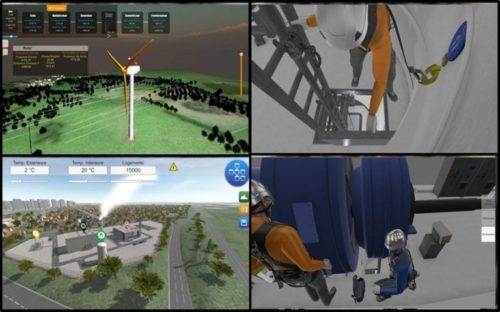EAST

- Partners : Académie de Créteil, AFPA, CESI, Dassault Systèmes, Emissive, ENIB, INSA de Rouen, ORT France, Région Picardie (WinLab d’Amiens)
- Start of project: April 2013
- End of project: July 2016
- Call: PIA – e-Education n°2
- CESI Budget: 343.600 €
Presentation
The ambition of the EAST project is to restore the interest of young people towards STEMS, and to increase the status of professional and technological education, through innovative educational situations based on the study of real industrial objects or real technical systems.
The project proposes 3D virtual environments, allowing to learn by resolving concrete problems. In order to give meaning to learning, the objects which are studied are themselves objects that contribute to solve main contemporary issues such as renewable energies, non-polluting transport systems, etc. The issues raised around these objects can be addressed at different level, from secondary education to higher education, including professional and technical education. This is possible because companies associated to the project provided the complex digital models used in learning situations.
Main results

The project demonstrated that producing attractive 3D learning environments from companies digital assets (3D model of the GE 1.5 MW wind turbine ; plans of the Thermulis thermal power station ; and their technical specifications) was feasible.
It has also demonstrated that considering pedagogical scenarios as external and modifiable data that are represented as UML diagrams, was also feasible when they are implemented as a library of primitives in a relevant programming environment (in this project, UNITY).
Finally, it has also demonstrated the diversity of possible usages of these simulators, for public of different levels, when they can access machines with appropriate configurations.
Near 3 200 learners, from Secondary School (Year 10) to the 4th year in Higher Education, tutored by more than sixty teachers, have experimented the simulator of the wind turbine, with a dozen of different pedagogical scenarios adapted to the different levels.
4 demonstrators were developed:
- GE 1,5 MW wind turbine simulator
- Learning security procedures to move inside the wind turbine
- Learning a preventive maintenance procedure in the wind turbine (control of the gear box)
- Simulator of a thermal power station with cogeneration.
Publications
BLANDIN, B. (2011) Using Industrial Assets to Build Learning Environments: A new Approach to Serious Gaming, in Emerging Technologies and Standardization for Learning, Education and Training – Industry – Education – Research Collaborations Create the Future of e-Education. Proceedings of the 24th ISO-IEC JTC1 SC36 Plenary and WG Meetings, International Open Forum, Shanghai (China): CELTSC – ECNU, p. 2-10.
BLANDIN, B. & QUERREC, R. (2014) Quelle méthode pour concevoir un environnement virtuel pour apprendre une activité ? Une tentative de réponse : le projet EAST, in Actes du 3e colloque international de Didactique Professionnelle, 28 et 29 octobre 2014 à Caen. (communication 4102).
TAOUM, J., QUERREC, R., SAUNIER, J., BLANDIN, B. (2015) EAST: Environnements d’apprentissage scientifiques et techniques, in Actes des Journées AFRV 2015, 28-30 Octobre, Aerocampus Aquitaine, Bordeaux, p. 11-17.
SAUNIER, J., BARANGE, M., BLANDIN, B., QUERREC, R. & TAOUM, J. (2016) Designing Adaptable Virtual Reality Learning Environments in Proceedings of the VRIC 2016, 23-25 March, 2016, Laval (France).
SAUNIER, J., BARANGE, M., BLANDIN, B., QUERREC, R. & TAOUM, J. (2016) A methodology for the design of pedagogically adaptable learning environments, in The International Journal of Virtual Reality, 16(1), p. 15-21
BLANDIN, B. (2016) Le projet EAST: des environnements d’apprentissage scientifiques et techniques, in Technologie n°202 (mars / avril 2016), p. 12-19. CANOPÉ Editions. BLANDIN, B. (2017) Numérique et didactique professionnelle : Quelques leçons du projet EAST, in Actes du Colloque DIDAPRO 2017, Lille (France) 6-8 juin 2017. Communication 4101